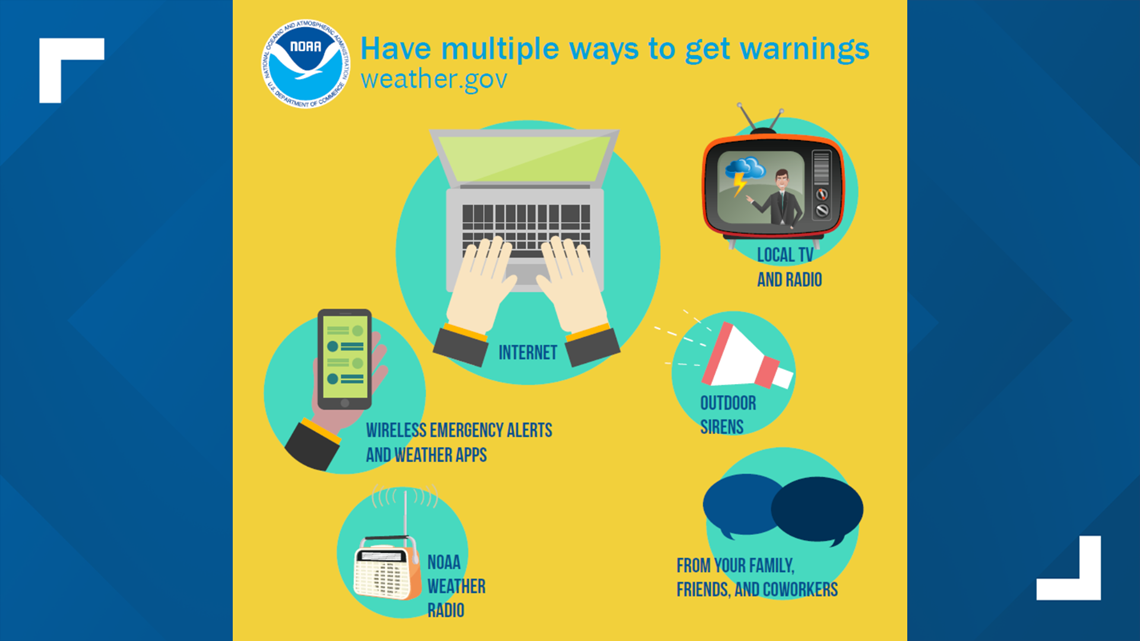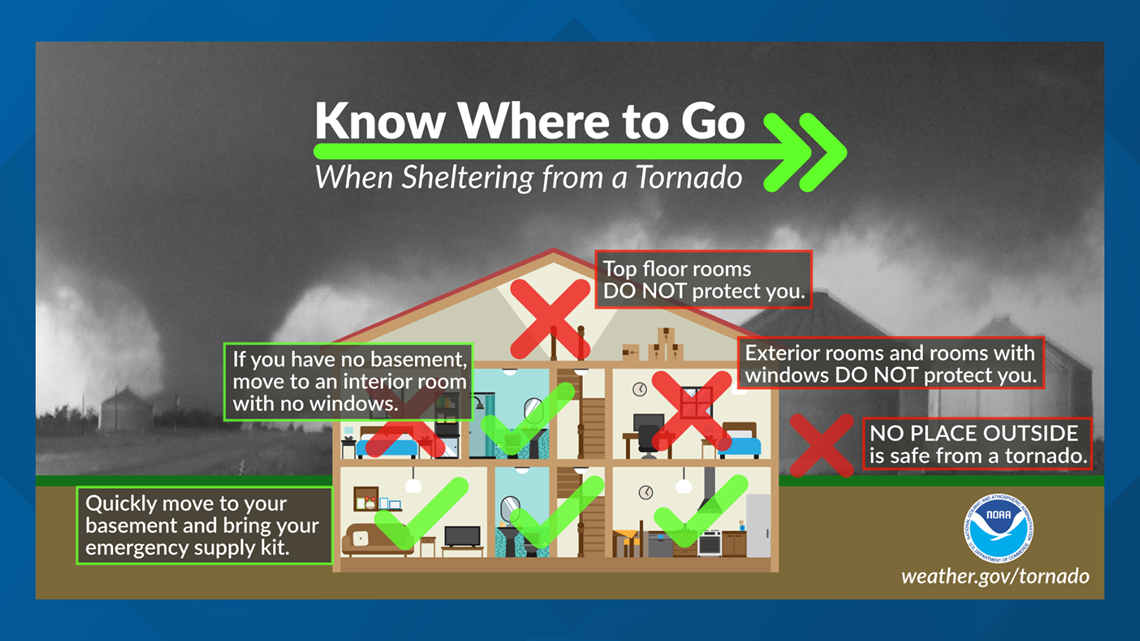TENNESSEE, USA — Knowing what to do when you see a tornado or when you hear a tornado warning can help protect you and your family.
According to the National Oceanic and Atmospheric Agency (NOAA), there is no guaranteed safety during a tornado so even the possibility of a tornado must be taken seriously.
During a tornado, people face hazards from extremely high winds and the risk of being struck by flying and falling objects.
With severe weather, it is crucial to have a plan. Prepare an emergency kit. Stay aware of weather conditions. Know where to find shelter.
EMERGENCY KIT:
- Water, non-perishable food, and medication
- Fresh batteries and a battery-operated TV, radio, or internet-enabled device to listen to the latest emergency weather information
- A list of important information, including telephone numbers
Be sure your children know what a tornado is, what tornado watches and warnings are, what county they live in (warnings are issued by county), and what makes a location a “safe shelter,” whether at home or at school.


STAYING AWARE OF WEATHER CONDITIONS:
If you know thunderstorms are expected, stay tuned to local radio and TV stations or an NOAA weather radio for further weather information. Some tornadoes strike rapidly without time for a tornado warning.
- A dark or green-colored sky
- A large, dark, low-lying cloud
- Large hail
- A loud roar that sounds like a freight train
If you notice any of these conditions, take cover immediately, and keep tuned to local radio and TV stations or to an NOAA weather radio or check the internet.


FINDING A SAFE SPACE:
Falling and flying debris cause most deaths and injuries during a tornado. Although there is no completely safe place during a tornado, some locations are much safer than others. The goal is to create as many barriers as possible between you and the flying debris in and near a tornado.
Remember: Get inside as close to the center of the building as possible. Get underground or to the lowest level possible. Cover up with pillows, blankets, coats and helmets to protect your head and body.
Below is a list of tips for finding shelter in different scenarios.
HOME
A basement, reinforced FEMA safe room or storm shelter is preferred, but if those are not an option, you need to get to a small room at the lowest level and stay far away from doors, windows, and outside walls.
- Bathrooms may be a good shelter, provided they are not along an outside wall and have no windows.
- A small interior closet might be an option. It should be as deep inside the building as possible, with no outside walls, doors or windows. Be sure to close the door and cover-up.
- If a hallway is your shelter area, be sure to shut all doors.
- The space underneath a stairwell could also be used as a shelter as long as it is not on an exterior wall or near doors and windows.
APARTMENT
- If you live on the upper floors and if your complex does not have a reinforced shelter, you should make arrangements to get to an apartment on the lowest floor possible.
- The apartment clubhouse or laundry room may be used as a shelter if they are accessible day and night, on the lowest floor and as far inside as possible.
MOBILE HOME
Taking cover under sturdy furniture, in a bathtub or closet or under a mattress will be meaningless in a mobile home if the home itself is destroyed, blown over, or rolled over by tornado or severe thunderstorm winds. Get out of mobile homes and find a more substantial shelter as quickly as possible.
- You will likely not be safe in a mobile home, whether you’re in a hallway, a closet or a bathroom.
- You need to have a plan to seek shelter somewhere else, and you should not wait for the tornado warning to put your plan in motion.
OUT IN PUBLIC
Severe weather can strike anywhere at any time. There is a myth that tornadoes don't hit urban areas, but this is false. Even if you are away from home in a large city, you should stay alert when severe weather threatens.
- Business owners and venues should make a plan to keep customers and clients safe.
- You should follow the basic shelter rules of getting low to the ground and away from exterior walls, doors and windows.
HOTEL OR MOTEL
- Owners should consider having a plan for guests.
- Guests should be aware of the weather and ask if there is a plan. If not, you should make your own.
- Avoid open hallways that have doors and/or windows on either end.
- Interior bathrooms and closets near the center of the building on the lowest floors may be good shelters in this situation.
IN A VEHICLE
Any sort of vehicle is a terrible place to be when there is even a threat of severe weather. If faced with a tornado threat while on the road, your best course of action will depend on your exact location, the tornado's location, speed, and direction of movement, road options available to you, nearby structures, time of day, traffic and weather conditions you're experiencing.
- Delay your trip until the weather passes when possible.
- Be familiar with the area. Keep a highway map handy, one that includes the county names and boundaries. NWS severe weather warnings are issued based on counties. If you do not know what county you're in you could miss life-saving information.
- Find a station broadcasting weather information. A battery-operated weather radio is essential for travelers. Remember you will not get any warnings if you are listening to CDs or satellite radio in your vehicle.
- If the tornado is far enough away and road options and traffic allow, you should try to find a substantial building for shelter. Truck stops, convenience stores, restaurants and other businesses to be adequate shelters in a tornado situation. Walk-in coolers can sometimes make a good shelter.
- Never try to outrun a tornado in your vehicle. Find a road option that will take you out of its path (while avoiding other storms) and to safe shelter, if possible
- Never use a highway overpass as a tornado shelter.
- The worst-case scenario for motorists would be to be trapped in your vehicle on the road with no escape possible. It is in these situations when it may become necessary to leave your vehicle and seek shelter in a ditch, culvert or low spot ONLY AS A LAST RESORT.


OUTDOORS
Being exposed outdoors is one of the worst places to be in a tornado or severe thunderstorm.
- Organized outdoor events, including sporting events at all times of year, should have weather safety plans.
- Event coordinators or managers should have a detailed severe weather safety plan in place and practice it.
- People at large outdoor gatherings or events should listen when severe weather information is conveyed and follow instructions if a safety plan is put into action.
- Ditches, culverts and ravines should be used only as an absolute last resort. If you must leave your vehicle to seek shelter in a ditch, you should try to get as far away from the vehicle and any other potential debris as possible.
AFTER A TORNADO OCCURS:
- STAY INFORMED: Continue to listen to local news or an NOAA Weather Radio to stay updated about tornado watches and warnings. Multiple rounds of thunderstorms capable of producing tornadoes are possible during severe weather outbreaks.
- CONTACT YOUR FAMILY AND LOVED ONES: Let your family and close friends know that you're okay so they can help spread the word. Text messages or social media are more reliable forms of communication than phone calls.
- ASSESS THE DAMAGE: After the threat for tornadoes has ended, check to see if your property has been damaged. When walking through storm damage, wear long pants, a long-sleeved shirt, and sturdy shoes. Contact local authorities if you see power lines down. Stay out of damaged buildings. Be aware of insurance scammers if your property has been damaged.
- HELP YOUR NEIGHBOR: If you come across people that are injured and you are properly trained, provide first aid to victims if needed until emergency response teams arrive.
Learn more about how to stay safe during a tornado on the CDC's website.

